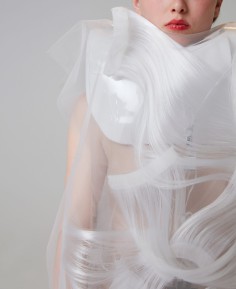YING GAO
Possible Tomorrows

source:dezeencom
Fashion designer Ying Gao has created a collection of robotic dresses, with fibrous panels that delicately twist and curl when they identify strangers nearby.
The Possible Tomorrow’s collection is inspired by Gao’s interest in the notion that clothing is often seen as a protective barrier.
The dresses’ movements are triggered by a fingerprint scanner built into a wooden frame that sits around the wearer’s neck.
The device sends to data to a microprocessor that uses Arduino – an open-source electronics platform – and if it doesn’t recognise the fingerprint, it triggers motors embedded in each of the panels.
Fingers that are placed on the scanner more than once, and therefore no longer “strangers”, will have no effect on the dress.
“The purpose of the project is to subvert the logic of security so that garments become anti-security objects,” Ying Gao told Dezeen. “The logic of security has become a political technology, that too often prevents us from emancipating. I would like these garments to open up to people that are strangers.”
“The idea is that you can never make the dress move twice.”
All of the dresses are made from gauzy nylon mesh, while translucent thermoplastic has been used for the threads in the kinetic panels. All materials were specifically chosen by Gao for their flexibility and strength.
When motionless, the thread panels form flattened curves that are meant to echo the hypotrochoid patterns created by retro games like Spirograph, which partly informed Gao’s designs.
“The challenge in terms of fashion design is to contract garments with free-flowing dimensions affording the potential for numerous shapes,” the designer explained.
Based in Montreal, Ying Gao has previously created dresses with integrated eye-tracking systems that move and light up when under someone’s gaze. The fashion designer’s Walking City collection also incorporated concealed pneumatic pumps so that the clothes appeared to breathe when their origami-style folds filled with air.
.
.
.
.
.
.
.
source:yinggaoca
Interactive clothing with fingerprint recognition technology, that acknowledges only strangers
2017
Nylon mesh, Super organza, Nylon thread, PVDF thread, thermoplastic, electronic devices.
The two robotised garments are connected to a fingerprint recognition system. However, through bypassing the notion of security, they only become animated in the presence of strangers whose fingerprints aren’t recognised by the scanner.
The aesthetic and motion of these garments evoke hypotrochoids, shapes borrowed from the vintage game Spirograph: their flattened curves are drawn by a single point linked to a mobile circle that rolls without sliding, on and inside of an initial circle. This design was developed from a series of algorithms linked to the realm of pattern recognition, or scatter graph.
.
.
.
.
.
.
.
source:thefashionatlascom
Possible Tomorrows è l’ultimo progetto realizzato dalla fashion designer Ying Gao.
La designer, ricercatrice e docente universitaria Ying Gao continua a stravolgere il rapporto tra abbigliamento e strumento tecnologico: la sua ultima collezione, Possible Tommorows, è composta da abiti robotizzati in grado di interagire con le persone circostanti.
Gli abiti sono collegati ad un sistema di riconoscimento delle impronte digitali. Ogni indumento si anima solo in presenza di persone le cui impronte non sono riconosciute dallo scanner.
I movimenti poetici di ogni capo ricordano le forme geometriche dello spirografo: i disegni realizzati dal movimento sono sviluppati da una serie di algoritmi risalenti ai pattern da cui traggono origine.
Gli abiti di “Possible Tomorrows” sono costituiti da nylon, PVDF, dispositivi elettronici e termoplastici: materiali tecnologici con i quali Ying Gao indaga l’aspetto sociale dell’abito, visto come una barriera protettiva.
Un progetto tecnologico che cerca di instaurare una nuova idea di interazione tra gli esseri umani. “Animarsi” per uno sconosciuto abbatte le barriere relazionali che la sicurezza, priorità politica della nostra storia contemporanea, ha costruito.
Essere al sicuro, protetti da un abito, spesso ci blocca e ci impedisce di aprirci alle persone estranee: Ying Gao smonta questo preconcetto e mira ad un’idea non convenzionale della sicurezza e dell’interazione.
.
.
.
.
.
.
.
source:textileindustryningcom
MODA + ARTE + TECNOLOGIA, parecem 3 palavrinhas difíceis de se juntar, mas, não para Ying Gao.
Professora e designer de moda, além de ensinar, ela dá vida às suas criações super diferenciadas. Vestidos robóticos. Então, o que exatamente um vestido robótico faz? No caso das criações de Gao, os vestidos são animados principalmente para adotar o comportamento de uma coisa viva em resposta aos estímulos externos.
Apesar das amplas variações na capacidade tecnológica dessas coleções, cada peça individual possui uma qualidade etérea comum, romântica e mundana.
Os materiais variam do algodão, nylon, couro ao termoplástico e a super organza, que flutua como nuvens.
Transformando o metafórico no literal, como só o casamento da ciência e da arte pode fazer, Gao utiliza a tecnologia para dar vida às peças de vestuário com qualidades poéticas e interativas, assim como a relação do corpo com as roupas.

